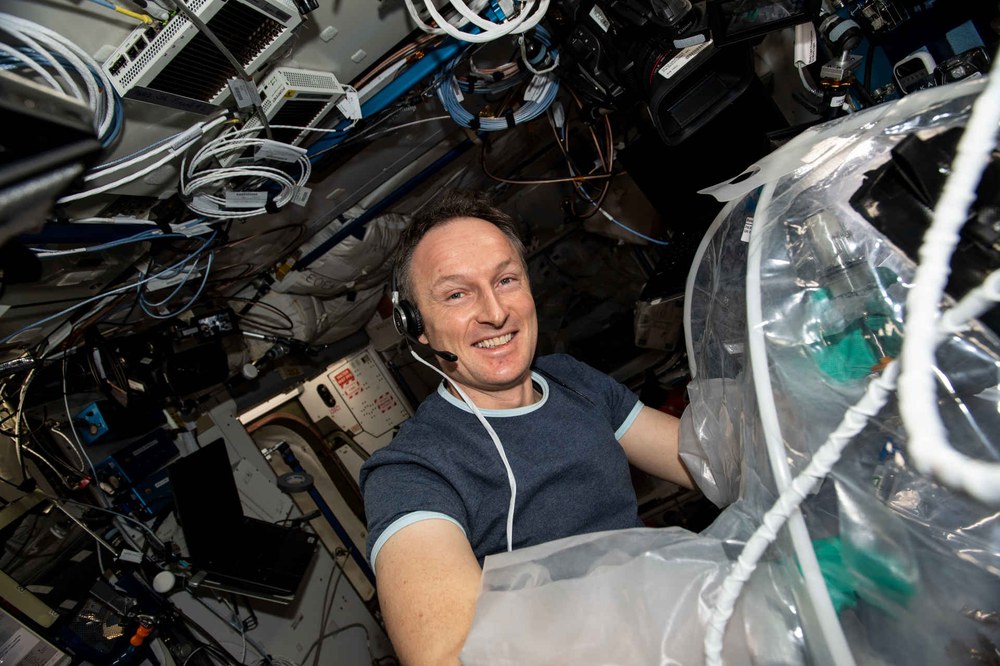Matthias Maurer tests concrete on the International Space Station (ISS)

- Matthias Maurer is conducting research into how concrete hardens in microgravity.
- Climate protection through more efficient use of raw materials.
- Experiments in space generate data for technological developments on Earth.
- DLR is collaborating with the universities of Cologne and Duisberg-Essen.
- The experiment is part of the Cosmic Kiss mission.
- Focus: Space, International Space Station, ISS, materials science, climate protection, construction materials, concrete
How does freshly poured concrete behave in microgravity? And how can this contribute towards environmental protection on Earth? In early February 2022, German ESA astronaut Matthias Maurer conducted research into these issues on board the International Space Station (ISS). The 'MASON/Concrete Hardening' experiment is being carried out jointly by the German Aerospace Center (Deutsches Zentrum für Luft- und Raumfahrt; DLR), the University of Cologne and the University of Duisburg-Essen as part of the Cosmic Kiss mission.
Global carbon dioxide (CO₂) emissions amount to approximately 38 gigatonnes (38,000,000,000 tonnes) annually. Some three gigatonnes of this are generated in the manufacture of cement alone. Cement is the primary component of concrete, which is currently the most widely used building material. Optimising the use of concrete by applying modern processes could contribute to improving the climate balance.
"Concrete as a material has been known to humankind for thousands of years, yet there are still a number of unknowns. We want to clarify some of these issues with Matthias Maurer on the ISS," says Matthias Sperl of the DLR Institute of Materials Physics in Space.

Video: MASON/Concrete Hardening experiment: researching concrete in space; reducing emissions on Earth
Your consent to the storage of data ('cookies') is required for the playback of this video on Youtube.com. You can view and change your current data storage settings at any time under privacy.
Why is concrete being researched on the ISS?
Concrete is not generally associated with spaceflight. However, the permanent microgravity conditions on board the ISS makes it possible to obtain insights into the behaviour of materials that are only possible to a very limited extent in laboratories on Earth.
In addition to the mixing ratio and strengthening materials (reinforcement), the hardening of the material is key to the strength of concrete. This hardening or curing process determines the arrangement of the constituents inside the concrete and the distribution of trapped air bubbles.
Hardening is strongly influenced by gravity on Earth. In materials research, it is of great interest to study how this mixture of calcinated limestone and clay plus sand and water behaves without this influence. This allows a better understanding of the chemical and physical processes – while the findings can be used for optimising mixing ratios, which ultimately save valuable resources.
The hardening and drying process of concrete can take weeks or months. Research on the ISS is so important because this is the only place in which the unvarying conditions of microgravity prevail on a long-term basis.
The data obtained from Maurer’s experiments will also provide the basis and reference values for further study in laboratories on Earth. Here, microgravity can be simulated in clinostats for short periods of time.
"If we succeed in simulating microgravity, a large number of tests could also be carried out more quickly, easily and economically in the future," explains Martina Schnellenbach-Held of the Institute for Solid Construction (Institut für Massivbau; IfM) at the University of Duisburg-Essen. She and her team made the experiment possible in the first place by developing a special concrete mixer that meets the strict safety requirements for the ISS. This mixer is no bigger than a hand, and the concrete is mixed by hand.
How can humans build on the Moon and Mars?
MASON (material research on concrete in microgravity) has a cosmic component despite its terrestrial applications. If humanity realises its plans to establish a permanent presence on the Moon or Mars, its stations must be built of solid materials. This will primarily serve to protect against micrometeorites and cosmic radiation.
The formulas used in construction projects on Earth to calculate the structural characteristics of buildings are always based on the gravitational force of one 'g'. On the Moon, however, gravity is only one-sixth of this value, and it is not certain that simply adjusting the values would lead to a stable structure. Therefore, the data obtained through MASON is quite literally a vital building block.
The essential components of concrete are not available on the Moon or Mars, so Maurer is also examining samples made of artificially produced lunar dust.
Funding
The German Space Agency at DLR is supporting the work of researchers at the University of Cologne and the University of Duisburg-Essen with funding from the German Federal Ministry for Economic Affairs and Climate Action (Bundesministerium für Wirtschaft und Klimaschutz; BMWK).


